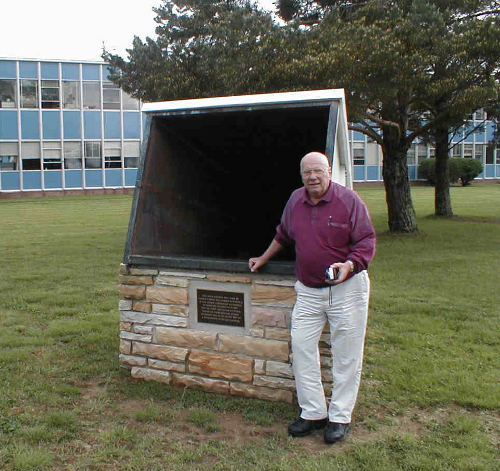 Doc Ewen with his original horn antenna, Green Bank WV, 2001 (Photo courtesy of Ewen family)
Doc Ewen with his original horn antenna, Green Bank WV, 2001 (Photo courtesy of Ewen family)
Harold I. "Doc" Ewen
Contributed by Ellen N. Bouton and Kenneth I. Kellermann
Harold Irving (Doc) Ewen was born March 5, 1922. He received his undergraduate degree from Amherst in 1942, then joined the Navy, first teaching celestial navigation for a pilot training program at Amherst College, then receiving radar training at Princeton and MIT before joining a Navy airborne squadron based in England.
After first contemplating Harvard Law then Harvard Business Schools, Ewen began graduate studies in physics at Harvard in 1946, where he initially joined in the development of the 95-inch Harvard Cyclotron and efforts leading to the first external beam, an achievement that was ultimately adapted for the treatment of brain tumors. His 1951 PhD thesis , "Radiation from Galactic Hydrogen at 1420 Megacycles per Second," reported on the first detection of a spectral line in radio astronomy. This work, which was done in collaboration with his advisor, Edward Purcell, was quickly confirmed by observers in The Netherlands and Australia. Although radio astronomy studies were pioneered in the United States by Karl Jansky and Grote Reber in the 1930s and 1940s, by 1950 other countries had taken the initiative, and the U.S. was falling behind in this rapidly developing new science with obvious military and political implications in the then current cold war mentality. Ewen's discovery quickly came to the attention of Bart Bok and other Harvard faculty and students who recognized the opportunity to not only study the galactic distribution of hydrogen, the most abundant element in the Universe, but also, using measurements of Doppler shift, galactic motions and galactic structure. Working together as co-Directors of the new Harvard Radio Astronomy Program, Bok and Ewen began the first PhD program in the United States, which led to the training of a new generation of radio astronomers, many of whom went on to become the future leaders of U.S. radio astronomy.
On the national front, in the mid-1950s Ewen was involved in the planning of a national facility for radio astronomy, and also participated in the site search which led to the selection of Green Bank WV as the best site for what became the National Radio Astronomy Observatory. During this period, he established the both the Ewen Knight and Ewen Dae Corporations. From 1989-1992, he served as Executive Vice President of Millitech Corporation, and from 1993 to 2000 as Vice President for Special Projects at Millitech. Beginning in 1992, he became President of EK Associates, and in 2004, the Technical Operations Director of Special Projects LLC.
Doc Ewen was an avid Red Sox fan, a passion that extended to building a ball field in the back yard on which he often played ball with his children. He remained active until his death on October 8, 2015 at the age of 93.
![[IAU logo]](iau_wb_thumb.jpg)
![[URSI logo]](URSI-logo-thumb.jpg)
![[Karl Jansky at his antenna]](jansky_photo_02_thumb.jpg)
![[Reber's Wheaton antenna]](Reber_Telescope_Wheaton_thumb.jpg)
![[Dover Heights]](Dover_Heights_02_thumb.jpg)
![[4C telescope]](GB61-195_4C_telescope_thumb.jpg)
![[Ewen and horn antenna]](ewen_horn1s.jpg)
![[Dwingeloo, 1956]](Dwingeloo-1956-thumb.jpg)
![[Jocelyn Bell Burnell and Cambridge antenna used in pulsar discovery]](burnell2_thumb.jpg)
![[Lovell Telescope at Jodrell Bank]](site_1594_0001-500-334-20180316163019-thumb150.jpg)
![[Wilson, Penzias, and Bell Labs horn antenna]](wilson-penzias-horn_thumb.jpg)
![[6-m Millimeter Radio Telescope in Mitaka, Japan]](6m-thumb.jpg)

